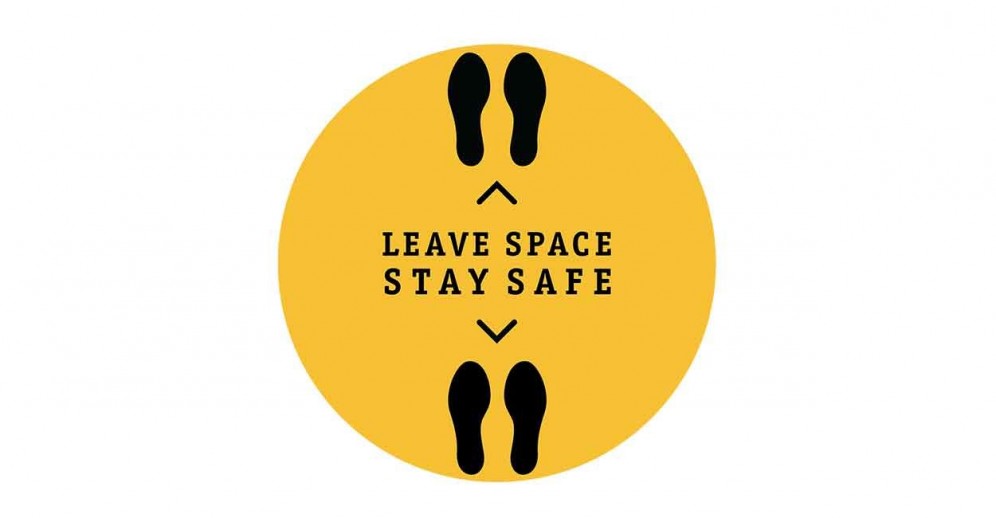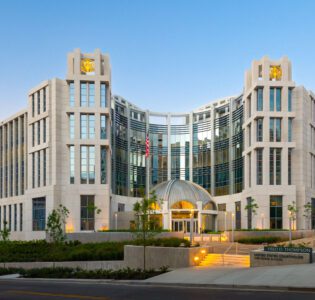COVID-19 + Airport Design: Enhancing Passenger Safety + Confidence
A WHITE PAPER BY FENTRESS ARCHITECTS
COVID-19 is forcing designers to reimagine the way the built environment is experienced. In particular, public transportation venues have been severely affected by the pandemic and many of their operators are searching for means to ensure passenger safety and build long-term user confidence.
In April 2020, we saw air travel in the U.S. reach an all-time low as passenger traffic dropped by more than 95%. As of June 2020, with travel bans and restrictions loosened and lifted, passenger traffic has begun to grow—albeit slowly.
Fentress Architects’ Aviation Studio formed a COVID-19 Committee at the outset of the pandemic. The objective of the Committee has been to provide airport operators and airlines with well-researched design strategies for the creation of healthy, safe and comfortable environments that maintain high levels of efficiency and are fiscally feasible. The Committee’s recommendations fall into two actionable phases: NOW and NEXT. A third phase – BEYOND – serves comprehensive planning efforts. Recommendations include touchless technologies, integrated safety measures, wayfinding solutions, queue management and more. This multi-phased approach will help mitigate the spread of today’s virus as well as future, yet unknown infectious diseases.
NOW: PRODUCE IMMEDIATE RESULTS
It’s crucial to respond quickly, efficiently and wisely in times of crisis. Entry screening, touchpoint reduction, wayfinding, queue management and new holdroom seating configurations are a few ways that simple modifications and additions can be employed to yield immediate and effective results.
Entry Screening
Health and temperature screening—via Infrared Thermal Detection Systems (ITDS) for Mass Screening—at entrances and security queues will help identify infectious persons. While research has shown temperature screening may not capture all cases of COVID-19 (it is possible for carriers of this disease to present without elevated temperature), it will detect a significant amount. And in doing so, this safety measure will instill confidence among travelers and staff in the facility’s procedures.
Reducing Touchpoints
Touchpoints, also known as occasions for human interaction, consistently emerge throughout the airport experience: from check-in to security, concessions and boarding. Given 80 percent of all infectious diseases can be transmitted through touch (Centers for Disease Control and Prevention), it is crucial to limit surface contact. Numerous technologies—facial recognition, artificial intelligence and biometric scanners—have already been employed to improve the passenger experience and reduce touchpoints.
Over the last five years, touchless, gesture-based kiosks have been gaining momentum at museums to enhance the check-in process and diminish wait times. Airports can leverage this same technology to transform self-serve kiosks from touch to touchless, which significantly reduces the risk of viral or bacterial transmission.
Wayfinding + Queue Management
Logical and logistical wayfinding strategies are essential to ensuring positive passenger experiences. Designers routinely utilize subtle, often unseen, wayfinding techniques to alleviate the stress of travel. However, the opposite is needed in a pandemic when travelers yearn for “can’t miss it” strategies that reduce uncertainty and anxiety.

Several temporary solutions, such as Arconas’ ‘Leave Space’ Floor Stickers placed six feet apart in queuing areas, encourage physical distancing while also guiding passengers. We’ve seen these ad-hoc methods used in almost every building type – from coffee shops and grocery stores to civic buildings and even airports. However, a more effective solution for airports requires a strong focus on queue management.
Holdroom Seating Configuration
In the traditional “Serpentine” security queue, passengers face one another as they navigate their way to the checkpoint, making it nearly impossible to avoid face-to-face contact.
Alternatives like the “Ski Lift” queue ensure all passengers remain front facing. Social distance stickers coupled with a “Ski Lift” queue would be highly effective in reducing the spread of germs.
Security Checkpoints
Now that we have discussed queue management, it’s time to integrate this measure into the bigger picture: improving the entire security checkpoint process.
First and foremost, airports must ensure all building users –TSA officers, airport and airline staff, and passengers – are protected throughout the entire airport experience. Since pre-COVID-19 security checkpoints are prone to human-to-human contact, it’s essential to rethink the process with safe and health-driven improvements.
Here are some easily implemented methods to enhance comfort and safety at security checkpoints:
- Enforce social distancing and front-facing flow in the queue
- Passenger temperature screening prior to proceeding through the checkpoint
- Protect TSA officers behind Plexiglass screens
- Provide handwashing stations after high-traffic contact areas
Holdroom Configuration
Pre-COVID-19 holdroom layouts provide little to no social distancing. Cross traffic obliterates social distancing requirements, resulting in only three feet of space between individuals as they walk down an aisle.
So, we’ve reimagined holdroom seating configurations to ensure passenger comfort without a reduction in capacity. By rotating the seating, airports can significantly increase usability of existing seating capacity.
Additionally, we collaborated with designer Michael McCoy to create a shield add-on for Arconas’ Place® Chair, which adheres to social distance guidelines.
Additional seating solutions include the transformation of otherwise unused areas, like concession seating, into additional holdroom space.
NEXT: EXPONENTIALLY BETTER
“Now” proposes strategies and solutions to be implemented within a matter of weeks and when passenger volumes are at their lowest. Meanwhile, “Next” includes strategies and solutions that need longer to fully implement and occur with increasing passenger volumes. They expand on phase one in both size and scope: from touchpoint reduction to touchless; from spacing to orientation for both queuing and holdrooms.
Touchless Experience
Simply put, it isn’t enough to reduce touchpoints; the airport experience must evolve to be touchless. Touchless environments not only expedite and enhance all aspects of travel, they also improve health.
The world’s first fully biometric terminal was created for Delta Airlines at Atlanta’s Hartsfield Jackson International Airport. It integrates biometrics from curb to gate, which not only removed touchpoints, it also saved an average of nine minutes when boarding a wide body aircraft alone. At the Fentress-designed South Terminal Complex for Orlando International Airport, biometric boarding gates will help reduce surface contact while creating a more efficient boarding process.
Airports may also choose to limit surface contact in elevators with solutions like MAD Elevator Inc.’s “Kick-to-Go,” which is comprised of foot-activated buttons, and “Touch-to-Go,” which provides easy-to-clean elevator touchscreens.
Expansion of low-touch concession opportunities will further enhance the passenger experience. Earlier this year, Los Angeles International Airport adopted this strategy to pilot an on-demand food service program in Terminal 2. The service incorporates a ‘ghost kitchen’, which allows passengers to pre-order for pickup while the food is prepared in an existing kitchen space within the terminal. This sustainable model is an efficient solution, avoiding the need for new construction and infrastructure.
While the addition of dividers between seats in holdrooms is an important first step, furniture options such as Arconas’ Place® Chair Cluster and Radius Dividers maximize personal space for passengers while optimizing seat utilization. The incorporation of leaning rails throughout concourses can also help mitigate touchpoints and offer operators more easy-to-clean surfaces.
Expand Outdoors
Working closely with designers, airports can expand seating to outdoor areas to accommodate higher passenger levels while allowing for social distancing. At the Austin-Bergstrom International Airport (above), Fentress’ design expanded the holdroom outdoors, establishing an efficient way to optimize the site’s unused space.
Outdoor holdroom seating offers benefits far beyond increased space. It also provides natural ventilation for passengers, promoting passenger well-being while maintaining a healthy and comfortable atmosphere.
BEYOND: EXPANDING THE SCOPE OF POSSIBILITY
While it’s easy for the industry to focus on short-term survival, airports and designers must take a responsive and resilient approach to adapt to a post-COVID-19 world. Ultimately, our goal as airport designers is to create physical environments that instill passenger and consumer confidence in the world’s aviation system for the long term. This forward-thinking approach requires a design strategy that far surpasses implementation of COVID-19 protocols; it requires designing flexibility and resiliency into structures that can easily acclimate to unforeseen conditions for the next 20 years and beyond.
Technology is the Future
Technology has been a catalyst for airport design innovations long before the current pandemic. But now, more than ever, it will be essential in creating flexible buildings while ensuring passengers stay informed and connected. Automation technology such as robotics will become more common to provide passengers with pertinent information, improving airport efficiency and service. Incheon International Airport adopted this technology early on, incorporating customer-facing robots to advise passengers throughout the airport journey.
AI (Artificial Intelligence) will help improve airport operations and facilitate safety measures. At Seattle-Tacoma International Airport, an airside artificial intelligence system will enhance aircraft taxing, gate allocation and turnaround. The airport also implemented visual sensors to monitor passenger line lengths to help improve efficiency while facilitating queue management.
Leveraging Digital Technology
Capitalizing on digital technology will also be paramount to the future of airport design. Our aviation experts have taken forward-thinking approach to the holdroom boarding experience by creating a concept for a new podium that supports social distancing with a built-in shield between passengers and airline staff. This visually informative LED screen also provides 360-degree coverage, empowering passengers to remain in their seats while staying updated with flight information.
Resilient Public Spaces
Resiliency is key when it comes to designing public spaces. Public areas in airports of the future will need to accommodate more space for separation between passengers while remaining flexible to respond to health issues that could arise.
Other passenger-facing areas such as ticket counters, security checkpoints and holdrooms will also need to be highly configurable to accommodate shifting passenger levels, safety protocols such as health scans and sporadic social distancing requirements.
Driving Wellbeing + Sustainability
The airport of the future has an opportunity to be a catalyst for public health. This strategy goes beyond cleaning surfaces; it places the wellbeing of users and the environment at the heart of the design. Designers can leverage building systems while setting ambitious energy efficiency targets to improve health of both passengers and the environment. The goal is to redefine the airport as an agent for health and a driver for a sustainable future.
While we can’t predict the future, we can employ flexible design strategies to mitigate the impact of uncertainty.

